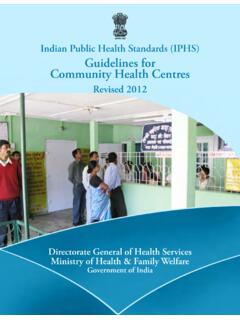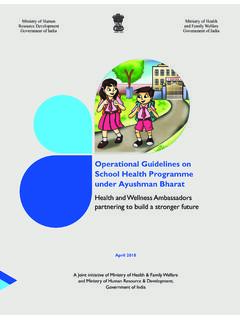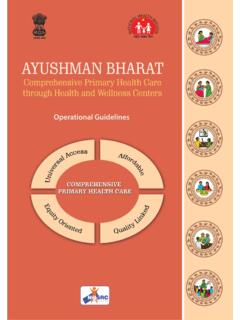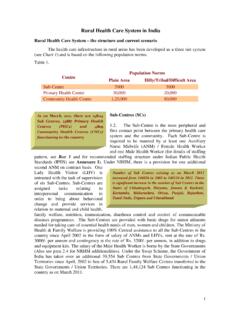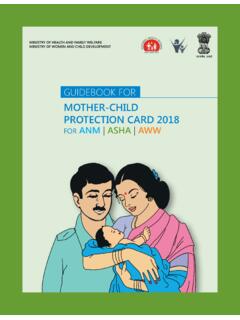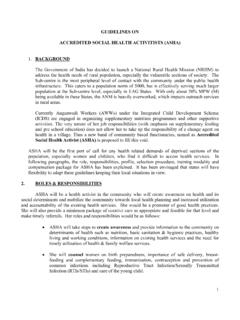Transcription of NATIONAL RURAL HEALTH MISSION - Home :: National …
1 NATIONAL RURAL HEALTH MISSION Meeting people s HEALTH needs in RURAL areas Framework for Implementation 2005-2012 Ministry of HEALTH and Family Welfare Government of India Nirman Bhawan New Delhi-110001 2 3 TABLE OF CONTENTS SUBJECT PAGE EXECUTIVE TIME LINE FOR NRHM ACTIVITIES 5-6 I BACKGROUND 7-8 II GOALS, STRATEGIES AND OUTCOMES OF THE NATIONAL RURAL HEALTH MISSION 9-15 III CRITICAL AREAS FOR CONCERTED ACTION 16-21 IV BROAD FRAMEWORK FOR IMPLEMENTATION 22-39 V KEY STRATEGY OR INSTRUMENT: DISTRICT HEALTH PLAN 40-62 VI PLAN OF ACTION OF THE MISSION 2005-2012 63-66 VII INSTITUTIONAL ARRANGEMENT 67-74 VIII SUPPORTIVE ACTION: COLLABORATIVE AGENCIES PARTNERSHISP WITH THE NON GOVERNMENTAL SECTOR 75-86 IX HUMAN RESOURCES SUPPORT FOR THE MISSION 87-89 X FINANCES FOR THE MISSION 90-96 XI MONITORING AND REVIEW 97-112 4 ANNEXES.
2 I Existing Schemes to come under the NRHM from the XI Plan 116-120 II Service Guarantees for HEALTH Care 121-127 III Annual Fund requirement for Sub-Centres 128-134 IV Assessment made by the NATIONAL Commission on Macro Economics and HEALTH 2005 135-139 V NRHM Activities and Norms 140-146 VI Draft Memorandum of Understanding (MoU) 147-167 VII Facility survey format for chcs 168-177 VIII Facility Survey Formats for Sub Heath Centres 178-183 IX Facility Survey Formats for PHCs 184-192 X Village HEALTH Information Schedule Household Formats 193-196 XI Criteria for Accreditation of 24 hour Comprehensive Emergency Obstetric Care 197-200 5 6 7 8 9 10 11 TIME LINE FOR NRHM ACTIVITIES Activity Phasing and time line Outcome Monitoring 1 Fully trained Accredited Social HEALTH Activist (ASHA) for every 1000 population/large isolated habitations.
3 50% by 2007 100% by 2008 Quarterly Progress Report 2 Village HEALTH and Sanitation Committee constituted in over 6 lakh villages and untied grants provided to them. 30% by 2007 100% by 2008 Quarterly Progress Report 3 2 ANM Sub HEALTH Centres strengthened/established to provide service guarantees as per IPHS, in 1,75000 places. 30% by 2007 60% by 2009 100% by 2010 Annual Facility Surveys External assessments 4 30,000 PHCs strengthened/established with 3 Staff Nurses to provide service guarantees as per IPHS. 30% by 2007 60% by 2009 100% by 2010 Annual Facility Surveys External assessments 5 6500 chcs strengthened/established with 7 Specialists and 9 Staff Nurses to provide service guarantees as per IPHS.
4 30% by 2007 50% by 2009 100% by 2012 Annual Facility Surveys. External assessments. 6 1800 Taluka/ Sub Divisional Hospitals strengthened to provide quality HEALTH services. 30% by 2007 50% by 2010 100% by 2012 Annual Facility Surveys. External assessments. 7 600 District Hospitals strengthened to provide quality HEALTH services. 30% by 2007 60% by 2009 100% by 2012 Annual Facility Surveys. External assessments. 8 Rogi Kalyan Samitis/Hospital Development Committees established in all chcs /Sub Divisional Hospitals/ District Hospitals. 50% by 2007 100% by 2009 Annual Facility Surveys. External assessments. 9 District HEALTH Action Plan 2005-2012 prepared by each district of the country. 50% by 2007 100% by 2008 Appraisal process.
5 External assessment. 10 Untied grants provided to each Village 50% by 2007 Independent 12 HEALTH and Sanitation Committee, Sub Centre, PHC, CHC to promote local HEALTH action. 100% by 2008 assessments. Quarterly Progress reports. 11 Annual maintenance grant provided to every Sub Centre, PHC, CHC and one time support to RKSs at Sub Divisional/ District Hospitals. 50% by 2007 100% by 2008 Independent assessments. Quarterly Progress Reports. 12 State and District HEALTH Society established and fully functional with requisite management skills. 50% by 2007 100% by 2008 Independent assessment. 13 Systems of community monitoring put in place. 50% by 2007 100% by 2008.
6 Independent assessment. 14 Procurement and logistics streamlined to ensure availability of drugs and medicines at Sub Centres/PHCs/ chcs . 50% by 2007 100% by 2008. External assessment. 15 SHCs/PHCs/ chcs /Sub Divisional Hospitals/ District Hospitals fully equipped to develop intra HEALTH sector convergence, coordination and service guarantees for family welfare, vector borne disease programmes, TB, HOV/AIDS, etc. 30% by 2007 50% by 2008 70% by 2009 100% by 2012. Annual Facility Surveys. Independent assessments. 16 District HEALTH Plan reflects the convergence with wider determinants of HEALTH like drinking water, sanitation, women s empowerment, child development, adolescents, school education, female literacy, etc.
7 30% by 2007 60% by 2008 100% by 2009 Appraisal process. Independent assessment. 17 Facility and household surveys carried out in each and every district of the country. 50% by 2007 100% by 2008 Independent assessment. 18 Annual State and District specific Public Report on HEALTH published 30% by 2008 60% by 2009 100% by 2010. Independent assessment. 19 Institution-wise assessment of performance against assured service guarantees carried out. 30% by 2008 60% by 2009 100% by 2010. Independent assessment. 20 Mobile Medical Units provided to each district of the country. 30% by 2007 60% by 2008 100% by 2009. Quarterly Progress Report. 13I. BACKGROUND The State of Public HEALTH in India 1.
8 India has registered significant progress in improving life expectancy at birth, reducing mortality due to Malaria, as well as reducing infant and material mortality over the last few decades. In spite of the progress made, a high proportion of the population, especially in RURAL areas, continues to suffer and die from preventable diseases, pregnancy and child birth related complications as well as malnutrition. In addition to old unresolved problems, the HEALTH system in the country is facing emerging threats and challenges. The RURAL public HEALTH care system in many States and regions is in an unsatisfactory state leading to pauperization of poor households due to expensive private sector HEALTH care.
9 India is in the midst of an epidemiological and demographic transition with the attendant problems of increased chronic disease burden and a decline in mortality and fertility rates leading to an ageing of the population. An estimated 5 million people in the country are living with HIV/AIDS, a threat which has the potential to undermine the HEALTH and developmental gains India has made since its independence. Non-communicable diseases such as cardio-vascular diseases, cancer, blindness, mental illness and tobacco use related illnesses have imposed the chronic diseases burden on the already over- stretched HEALTH care system in the country. Pre-mature morbidity and mortality from chronic diseases can be a major economic and human resource loss for India.
10 The large disparity across India places the burden of these conditions mostly on the poor, and on women, scheduled castes and tribes especially those who live in the RURAL areas of the country. The inequity is also reflected in the skewed availability of public resources between the advanced and less developed states. 2. Public spending on preventive HEALTH services has a low priority over curative HEALTH in the country as a whole. Indian public spending on HEALTH is amongst the lowest in the world, whereas its proportion of private spending on HEALTH is one of the highest. More than Rs. 100,000 crores is being spent annually as household expenditure on HEALTH , which is more than three times the public expenditure on HEALTH .
